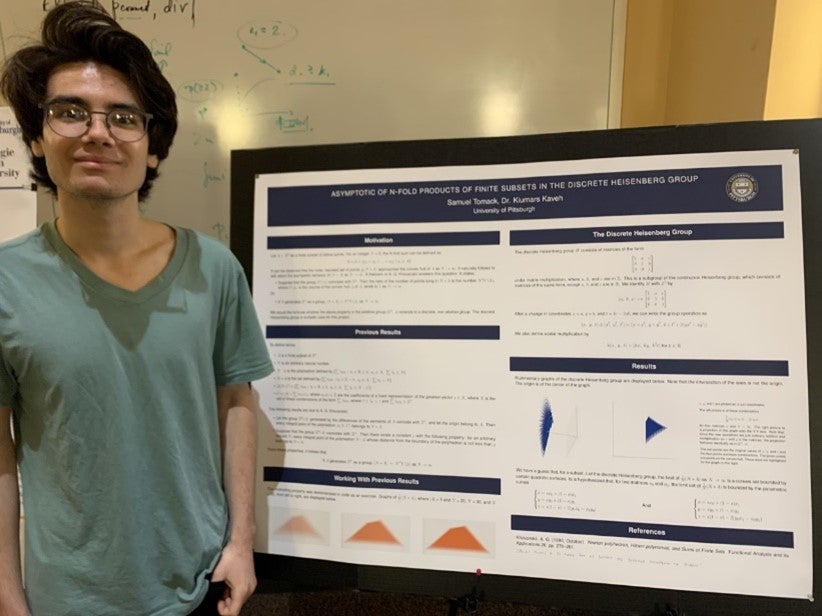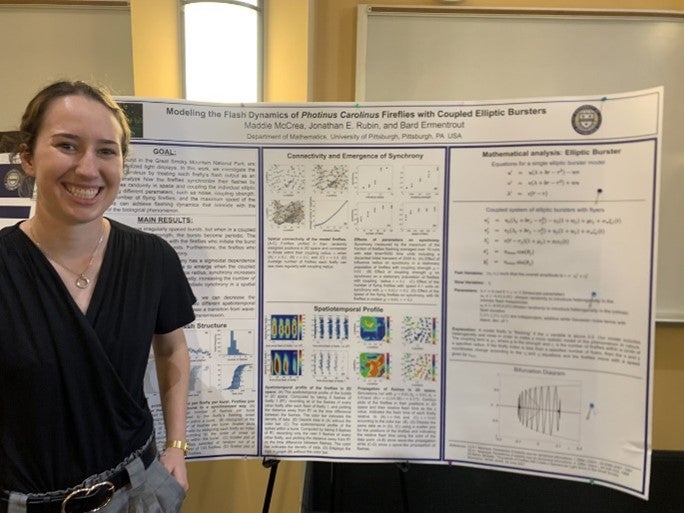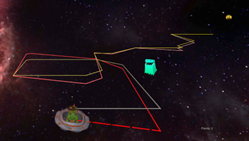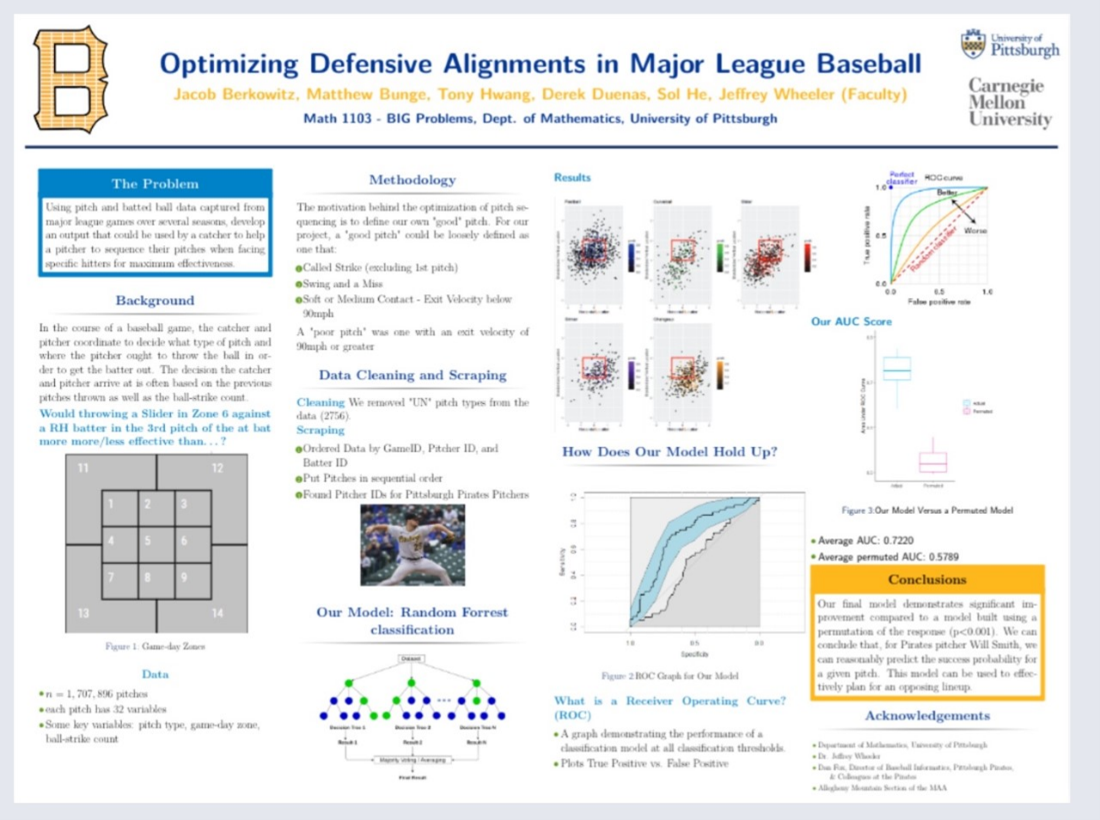Events
Mathfest
This year’s MathFest, our celebration of undergraduate research in the Math Department, was held in the Thackeray Hall lounge on Thursday April 14. It was an open house-style event featuring posters submitted by undergraduate researchers, many of whom were on hand to explain their work to interested visitors. Numerous department faculty and students stopped by to appreciate the posters, chat with the researchers, and enjoy the snacks provided.
A distinguished judging panel consisting of Drs. Gartside, Manfredi, and Swigon selected the top three projects to receive bookstore gift certificates donated by the department. They were:
- “Asymptotic of N-fold Products of Finite Subsets in the Discrete Heisenberg Group” by Samuel Tomack (mentored by Dr. Kaveh)
- “Modeling the Flash Dynamics of Photinus Carolinus Fireflies with Coupled Elliptic Bursters” by Maddie McCrea (mentored by Drs. Rubin and Ermentrout)
- “Heisenberg-Man”, a virtual reality game in the continuous Heisenberg group coded by Joshua Ascher (mentored by Dr. Schikorra).
Our Undergraduate Director Jason DeBlois thanks everyone who worked to make this event a success.

A few words from Samuel Tomack about the poster he presented:
"My poster is about the asymptotic behavior of N-fold products of finite subsets in the discrete Heisenberg group. The information presented is from a research project I am working on with Dr. Kiumars Kaveh. In particular, we are investigating whether certain theorems of A. G. Khovanskii regarding the asymptotic behavior of N-fold sums of finite subsets in the additive group (Z^n, +) extend to a discrete, non-abelian group."

A few words from Maddie McCrea about the poster that she presented:
"I was given the opportunity to work with Professor Ermentrout and Professor Rubin as part of the Painter Research Fellowship. We studied the flash dynamics of Photinus Carolinus, a type of firefly that synchronizes their flashes and creates a natural light show. In order to model the phenomenon, we treated the flash output of each firefly as a single elliptic burster and created a coupled system of the bursters in order to model the synchronization of flashes and match the quantitative observations seen in nature."

A few words from Josh Ascher about what he presented:
"I presented a game that was made into virtual reality. The motivation for the game was to help visualize a 3-dimensional space that differs from the standard space. In particular, the game was a sort of 3D-Pacman in the Heisenberg Group." More details can be found here: https://sites.pitt.edu/~armin/project/heisenbergman/
BIG Program

BIG Poster
This spring, Pitt students from multiple departments as well as three CMU math majors worked on three exciting projects in Dr. Wheeler’s BIG Problems class. These included working with 1.8 million data points to create an effective pitching strategy in Major League Baseball for the Pittsburgh Pirates, using time series and cleaned data to predict viewership for the local television station WPXI Channel 11, and an impactful project helping an oil and gas company analyze the economic feasibility of converting some energy production from fracking to solar.
The students presented their work at the Mathematical Association of America’s Allegheny Mountain Section spring meeting and as well at the department’s MathFest. In addition to presenting a deliverable to their client, the teams will present their work to the math department.
Below are the titles, abstracts, and presenters for the team's presentations at the recent MAA meeting:
- Title: Predicting Viewership through Machine Learning
Abstract: An attempt to predict viewership for WPXI channel 11 (a local Pittsburgh television station) using a time series SARIMA model and other machine learning techniques.
Presenters:
Jackson Filosa, Jada Graham, Michael Liu, and Ziyang Xu
*************************************************************************************
2) Title: Determining Economic Feasibility of Conversion From Natural Gas to Solar in Energy Production
Abstract: An analysis of natural gas and solar production was conducted in southwestern and northeastern Pennsylvania for a local oil and gas sales and leasing company, CX Energy. Work was done to build on previous work regarding most productive gas wells to analyze economic feasibility of producing energy using the following: solar irradiance hotspot analysis, well production data, landslide susceptibility data, decline curve analysis, and cost benefit analysis. Solar irradiance data was analyzed along with locations of the most productive gas wells to determine economic feasibility for CX Energy to incorporate solar energy into the oil and gas industry. The statistical programming language, R, was used to sort through well production data and plot locations in Pennsylvania with the highest production in an overall average per day rate by well permit number. Other factors used in the analysis include landslide susceptibility and topography of locations being considered, in an attempt to optimize placement of solar farms.
Presenters:
Anant Bajwa, Megan Darnell, Michael Gonzalez, Melanie Gottlieb, Zack Koerbel, and Daniel Rudy
**********************************************************************************
3) Title: Optimizing Pitch Selection Strategy in Major League Baseball
Abstract: Using data provided by the Pittsburgh Pirates, a model predicting pitch success via Random Forrest classification is offered. This model demonstrates significance as compared to a model built of a permuted response.
Presenters:
Sam Jacob Berkowitz, Matthew Bunge, and Dong Min Hwang (CMU). There are two other CMU students involved with this project, but they did not present.
4) In addition, Donna Hildebrandt presented her work on the open “Max Cut” Computer Science/Graph Theory problem at MathFest. Donna has worked under the supervision of Dr. Wheeler on determining a maximal bipartite subgraph in an arbitrary graph.